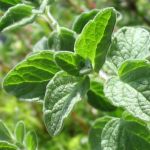| Common Name: |
Za'ater |
| Other Names: |
Syrian Oregano, Bible Hyssop |
| Botanical Name: |
Origanum syriacum syn. O. maru |
| Genus: |
Origanum |
| Family: |
Lamiaceae |
| Cultivation: |
Well-drained to dry, neutral to alkaline soil in sun. Origanum dictamnus needs sharp drainage and protection from wet winters. Orgianum majorana, O. x majoricum, and O. onites may be slightly hardier in a sheltered, sharply drained situation. |
| Propagation: |
By seed sown in autumn or at 10-13°C (50-55°F) in spring (species only); by basal cuttings in late spring; by division in spring. |
| Harvest: |
Plants are collected as flowering begins, and leaves during the growing season, and sued fresh, distilled for oil, or dried for infusions. |
| Native Location: |
Syria |
| Height: |
45-90cm (18-36in) |
| Width: |
30-45cm (12-18in) |
| Hardiness: |
Z8 |
| Parts Used: |
Leaves, Flowering tops |
| Properties: |
An aromatic herb with a thyme-oregano flavor. |
| Culinary Uses: |
An important ingredient of Za'ater (see Above description) |
| Economic Uses: |
Leaves and flowering sprigs are added to potpourris and scented articles. |
| Bibliography: |
Encyclopedia of Herbs by Deni Brown. Copyright © 1995, 2001 Dorling Kindersley Limited. pp 295-296
|

